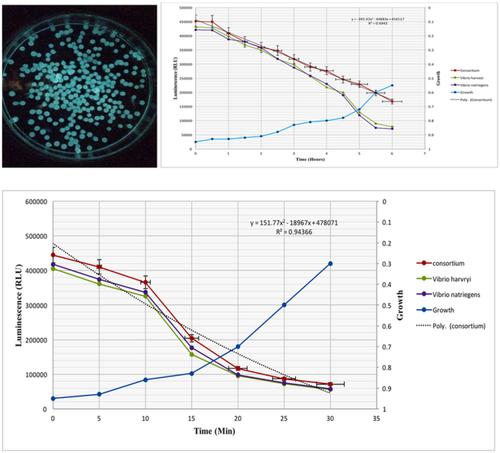当前位置:
X-MOL 学术
›
Luminescence
›
论文详情
Our official English website, www.x-mol.net, welcomes your feedback! (Note: you will need to create a separate account there.)
Influence of ultraviolet and gamma ray irradiation on luminescent bacteria and exploring their efficacy as biosensors
Luminescence ( IF 2.9 ) Pub Date : 2020-10-29 , DOI: 10.1002/bio.3972 Rashmi A Wanjari 1 , Arti S Shanware 1 , Sanjay J Dhoble 2
Luminescence ( IF 2.9 ) Pub Date : 2020-10-29 , DOI: 10.1002/bio.3972 Rashmi A Wanjari 1 , Arti S Shanware 1 , Sanjay J Dhoble 2
Affiliation

|
Toxicity monitoring of harmful radiation is an indispensable issue in modern radioecology. As bioluminescent bacteria have the simplest structure to epitomize the biosphere, their bioluminescence can also act as an indicator of the conditions, therefore assay systems based on luminous bacteria can be used to monitor environmental radiotoxicity. The present investigation explored the measurement of bacterial luminescence, which can be easily computed. Bioluminescent bacterial strains were used to evaluate the effect of ultraviolet (UV) and gamma irradiation. A random amplified polymorphic DNA (RAPD) assay was carried out to observe alterations under exposure. Using a phylogenetic tree, a comparative study of the effect of UV and gamma rays was carried out. The isolated strains showed marked sensitivity towards radiation exposure present in the environment and therefore they could be used as potential biosensing elements for developing an on‐site pollution monitoring biosensor.
中文翻译:

紫外线和伽玛射线辐射对发光细菌的影响并探索其作为生物传感器的功效
有害辐射的毒性监测是现代放射生态学中必不可少的问题。由于生物发光细菌具有最简单的结构来概括生物圈,因此它们的生物发光也可以作为条件的指示器,因此基于发光细菌的测定系统可以用于监测环境的放射毒性。本研究探索了细菌发光的测量方法,该方法很容易计算。生物发光细菌菌株用于评估紫外线(UV)和伽马射线照射的效果。进行随机扩增的多态性DNA(RAPD)分析以观察暴露下的变化。使用系统树,对紫外线和伽马射线的效果进行了比较研究。
更新日期:2020-10-29
中文翻译:

紫外线和伽玛射线辐射对发光细菌的影响并探索其作为生物传感器的功效
有害辐射的毒性监测是现代放射生态学中必不可少的问题。由于生物发光细菌具有最简单的结构来概括生物圈,因此它们的生物发光也可以作为条件的指示器,因此基于发光细菌的测定系统可以用于监测环境的放射毒性。本研究探索了细菌发光的测量方法,该方法很容易计算。生物发光细菌菌株用于评估紫外线(UV)和伽马射线照射的效果。进行随机扩增的多态性DNA(RAPD)分析以观察暴露下的变化。使用系统树,对紫外线和伽马射线的效果进行了比较研究。



























 京公网安备 11010802027423号
京公网安备 11010802027423号